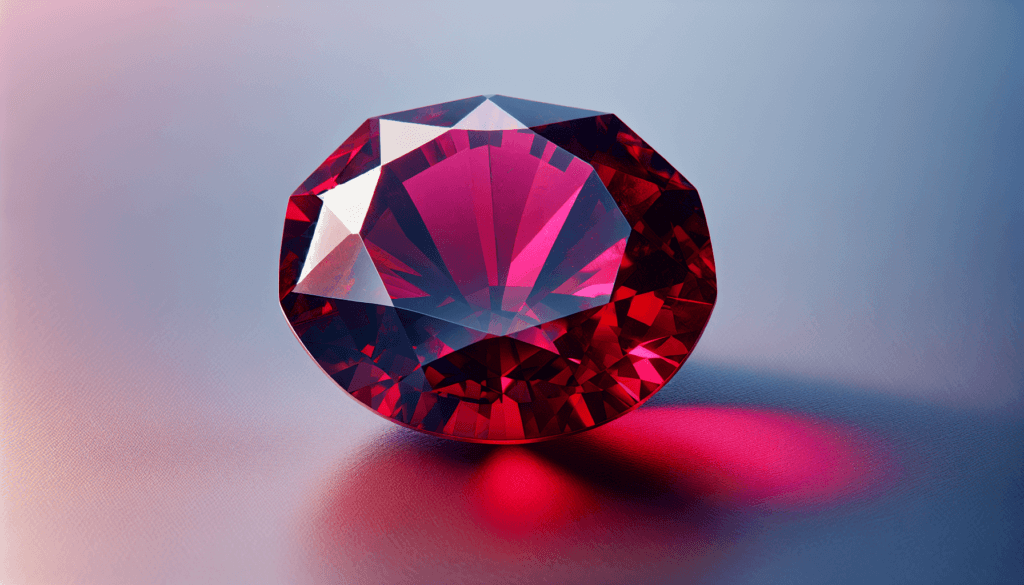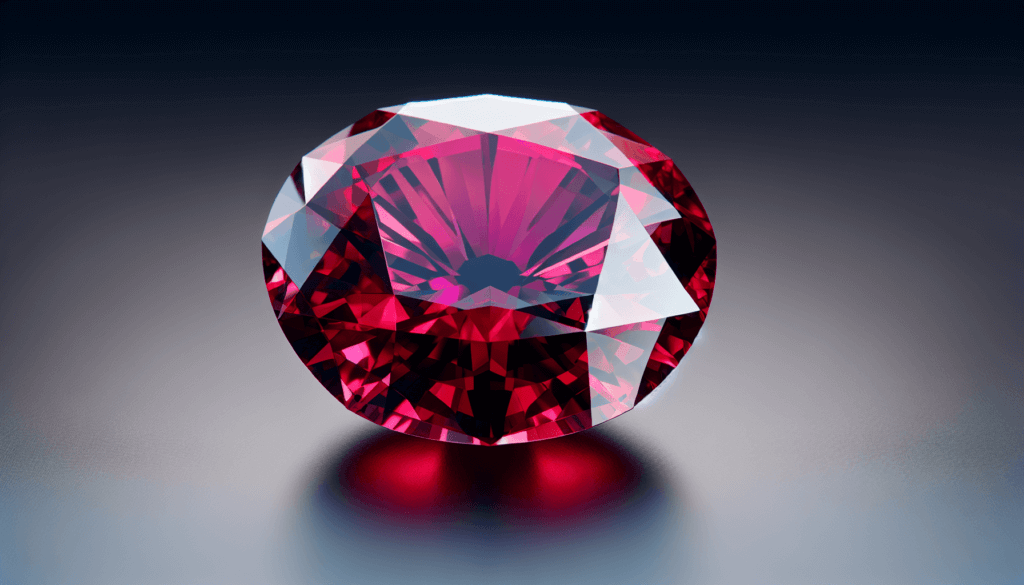Envision yourself on a treasure hunt journey, seeking out the world’s most exquisite gemstones. Your quest now takes you to the lustrous world of rubies, beautiful beyond belief and steeped in an array of unique characteristics. This enriching article, What Is Unique About Rubies? is your personal guide, crafted to unveil the distinctive allure, fascinating history, and incredible features these magnificent gems offer. Prepare to venture into the intriguing realm of rubies and learn what truly sets them apart from other precious stones.

Origins of Rubies
Rubies have a fascinating history, with their origins traced back to around thousands of years. These mesmerizing gems owe their existence to a complex process of mineral formation under the Earth’s crust, forged under extreme heat and pressure over time.
Geographical locations of ruby mines
Rubies are found in various locations around the world, ranging from bustling Southeast Asia to the tranquil landscapes of Africa. Myanmar, formerly Burma, is renowned for producing some of the highest quality rubies, particularly from the Mogok Valley. Sri Lanka, also called the ‘Island of Gems’, is another substantial source of rubies. Afghanistan, Vietnam, and countries in the African continent like Kenya, Tanzania, and Madagascar also have significant ruby mines.
Historical discovery and extraction of rubies
Historically, the discovery of rubies has been a matter of chance and exploration. Their extraction has evolved from simple mining techniques used by native inhabitants to today’s more sophisticated methods. It’s believed that the Mogok Valley in Myanmar has been active for nearly 1000 years, and rubies from Myanmar were traded on the Silk Road.
Efforts in artificial synthesis of rubies
From the 19th century onwards, scientists have made concerted efforts to synthesize rubies artificially to satisfy demand that natural sources could not meet. The artificial synthesis of rubies involves simulating the conditions under which they form naturally. Two popular methods are the Verneuil process and the hydrothermal process, which both have yielded impressive results over the years.
Physical Attributes of Rubies
General characteristics
Rubies, with their fiery red hue, are one of the most coveted gemstones. Their allure lies in their transparency and intense color, making them an immediate standout in any assortment of gems. The ruby is also a durable gemstone, second only to diamonds, making it suitable for a variety of jewellery pieces.
Color variations and causes
Color is a defining characteristic of rubies. The most sought-after color is a deep, vivid red, also known as ‘pigeon blood’ color. But they can range from pinkish to purplish and dark red. The chromium and iron content in rubies influence their color.
Size and weight of commonly found rubies
Rubies tend to be smaller than other gemstones, like sapphires and emeralds. It is rare to find large, fine rubies over 5 carats. Sizes above this are extremely rare and valuable, particularly those without any heat treatment.
Mohs scale hardness
On the Mohs scale of mineral hardness, rubies score a 9, second only to diamonds. This physical hardness makes rubies a highly valued gemstone for jewelry and industrial applications, as they can withstand everyday wear and tear.

Chemical Composition of Rubies
Impact of chromium on ruby’s color
Chromium is the reason behind the iconic red color of rubies. The presence of this element during the gem’s formation process gives rubies their distinctive hue. However, the amount and type of chromium present can affect the depth and shade of red, contributing to the range of colors seen in rubies.
Additional mineral inclusions
Aside from chromium, rubies may contain other mineral inclusions such as iron, titanium and vanadium. These can affect the gem’s color, clarity, and overall appearance. In some cases, these inclusions can enhance the appeal of rubies by giving them unique characteristics, like a star effect known as asterism.
Comparison of chemical composition with other gems
Rubies are essentially a red variety of the mineral corundum. While similar to sapphires in terms of composition, the key difference lies in the presence of chromium, which gives Ruby its red color. Sapphires, on the other hand, derive their color from other elements such as iron and titanium.
Treatment and Enhancement of Rubies
Common treatments applied to rubies
Typical treatments applied to rubies can involve heating them to improve color and clarity, as well as filling them with substances like lead glass to minimize the appearance of cracks or inclusions. Such enhancements can considerably augment a ruby’s visual appeal.
Impact of treatments on ruby’s appearance
The treatments can enhance a ruby’s color, ranging from a more vibrant red to purer hues, while also enhancing their clarity. There can be significant differences in the appearance of a treated ruby as compared to its untreated counterpart. However, it’s key to remember that treatments should be adequately disclosed to any potential buyer.
Controversies and ethics of treated rubies
While treatments can make rubies more accessible and affordable, there has been controversy regarding the ethics of treating rubies. The gem industry encourages full disclosure of such treatments. However, some believe that they can diminish a ruby’s value and authenticity.

Symbolism and Cultural Significance of Rubies
Rubies in folklore and mythology
Rubies have played a prominent role in many cultures’ folklore and mythology. In Hinduism, rubies were considered the ‘king of precious stones’. In ancient Greece and Rome, they symbolized love, passion, and power.
Symbolism in various cultures
The ruby’s vibrant red hue has made it a symbol of love and passion in various cultures. It is also seen as a token of prosperity and protection. In Chinese culture, for instance, rubies are commonly associated with vitality and life force.
Modern day representation and usage
Today, rubies are still highly valued for their symbolism. They are chosen to celebrate 40th wedding anniversaries and are used as birthstones for the month of July. High-quality rubies are also frequently used in haute couture jewelry.
Rubies in Jewelry
Popular ruby jewelry designs
Rubies are versatile, lending themselves to various jewelry designs. From classic solitaire rings and elaborate necklaces to minimalist earrings and bracelets, rubies can enhance any piece of jewelry with their vibrant color.
Care and maintenance for ruby jewelry
Given their hardness, rubies are relatively easy to care for. Regular cleaning with mild soap and warm water is typically enough. Ultrasonic cleaners can also be used, but steam cleaners should be avoided for treated rubies.
Impact of ruby’s characteristics on its use in jewelry
The characteristics of rubies – their vibrant color, luster, and hardness – make them an excellent choice for all kinds of jewelry. They can endure everyday use without losing their appeal, and their striking color brings a sense of luxury and style to any piece they adorn.
Combinations of rubies with other gemstones
Rubies are commonly combined with other gemstones in jewelry designs, most commonly with diamonds. The contrast between the fiery red of rubies and the sparkling white of diamonds creates a captivating visual interest.
Rubies in Technology
Use of rubies in laser technology
Aside from their beauty, rubies have practical applications in technology. They are fundamental in the creation of lasers, as their chromium content has spectroscopic properties useful in generating laser light.
Historical and current use in watchmaking
In watchmaking, rubies have both historical and current significance. Historically, they were used as bearings to reduce friction in watch mechanisms. Today, synthetic rubies serve the same purpose in high-quality timepieces.
Other technological applications of rubies
Beyond lasers and watches, rubies are used in other technologies, notably in scanning systems for supermarkets because of their durability and ability to refract light.
Economic Factors Surrounding Rubies
Price determinants for rubies
The cost of rubies is primarily determined by their color, clarity, cut, and carat weight. Natural, untreated rubies of high quality can fetch high prices, especially if they come from renowned regions like Myanmar.
Economic implications of synthetic rubies
Synthetic rubies offer a more cost-effective alternative to natural ones, which has significant implications for the gem trade. While they may lack the prestige of natural rubies, they have enabled a wider demographic to afford ruby jewelry.
Ruby trade and market trends
The global ruby market continues to show robust demand, especially for high-quality natural rubies. Meanwhile, trade restrictions and ethical considerations, such as concerns around artisanal miners’ conditions, can affect market dynamics.
Impact of ruby mining on local communities
Ruby mining can have a profound impact on local communities, creating jobs and contributing to economic growth. However, it can also lead to environmental degradation and social issues if not managed responsibly.
Rubies in Collective and Investment
Criteria for investment-grade rubies
Investment-grade rubies usually need to display exceptional color, excellent clarity, and good cut. They should preferably be natural and untreated, as these factors directly influence their value.
Historical and recent record-breaking ruby sales
Several rubies have made headlines at auctions, fetching mind-boggling prices. These include notable stones like the ‘Hope Ruby’ and ‘Sunrise Ruby’. Their sales underline the enduring allure and investment potential of high-quality rubies.
Pros and cons of investing in rubies
Investing in rubies can offer significant returns, given the right conditions. However, potential investors should also be aware of the risks, such as fluctuating market trends, and the expertise needed in assessing gem quality.
Potential risks and returns
Like any investment, rubies come with their own set of risks and rewards. While luxury goods like rubies often hold their value well, their market can be influenced by economic downturns and changes in consumer tastes.
Future of Rubies
Technological advancements in ruby synthesis
Advances in technology promise to make ruby synthesis more efficient and affordable than ever. This holds the potential to further democratize access to these beautiful gems.
Predicted market trends
The future of rubies appears bright, with rising economies and consumer demand for colored gemstones. Nonetheless, factors such as ethical considerations and the proliferation of synthetics will continue to shape the market.
Potential new uses for rubies in various industries
Sectors like technology and design are looking at the properties of rubies for potential new applications. Their hardness, durability, and ability to refract light might inspire innovative uses.
Sustainability and ethical considerations for the future of ruby mining
The mining of rubies will need to contend with increasing scrutiny over its environmental impact and labor conditions. The future will likely see a greater emphasis on sustainable, ethical mining practices, shaping the direction of the ruby industry for years to come.



